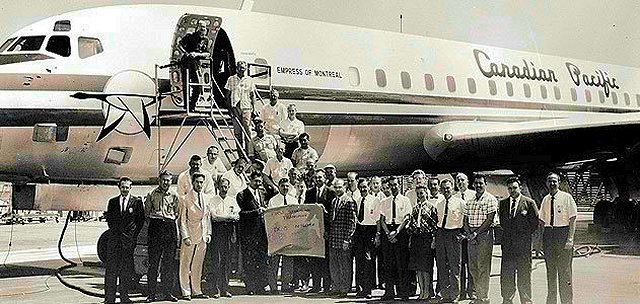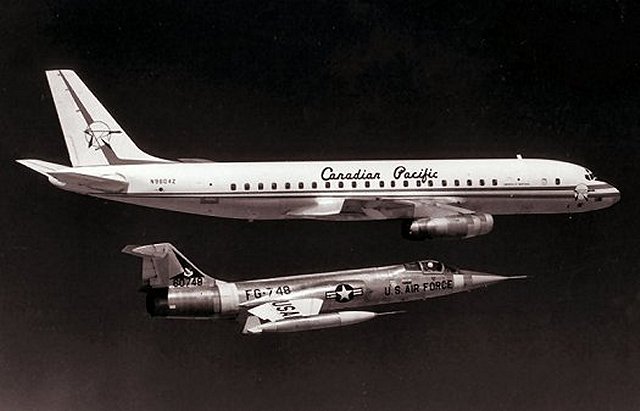


The first airliner to intentionally go supersonic was not the Anglo-French Concord nor the Russian TU-144. It was a DC-8-43. It was August 21, 1961.
The whole thing was a marketing stunt. Douglas wanted to get one up on Boeing. At the time Boeing was more than a year ahead of Douglas in the race to get the first american jetliner into service. PanAm started regular service with the 707 on October 26, 1958; Delta put the DC-8 in service for the first time on Sepember 18, 1959. The company that was first would probably set the standard for jet airliners in the US.
The plan was to takeoff from Long Beach, and ferry the airplane to Edwards, AFB, California. The next day they would takeoff from Edwards with minimum fuel, climb as high as they could then put the DC-8 into a dive until it exceeded Mach 1.0 and recover. Well the night before the flaps were damaged in a ground and did not work. This meant that they would be without the slats on the wing leading edges either since the slats extended with the flaps. They could takeoff without the flaps and every thing would be alright as long as they didn't lose an engine. If they did lose an engine on takeoff from Long Beach they would be unable to control the airplanet. With a Douglas flight test crew on board, and a temporary registration number N9604Z, they departed for Edwards.
The next day pilot William Magruder, copilot Paul Patten, flight engineer Joseph Tomish, and test engineer Richard H. Edwards took the DC-8 on it's test flight to exceed Mach 1.0. The only airliner, to this day, to intentionally do so other than the Concord and the Tupolev TU-144. At least as far as we know. Magruder climbed the big Douglas to 52,000 feet (a record in itself, at the time) because the speed of sound is less at that altitude. (Note: the speed of sound in the atmosphere is dependent only on the temperatrure. At Sea Level at standard temperature (15°C/59°F) Mach 1.0 = 661.7 kts; at 35,000 ft. (-54.3°C/-65.8°F) Mach 1.0 = 576.6 kts; at 50,000 ft.(-56.5°C/-69.7°F) Mach 1.0 = 553.8 kts.) Magruder then pitched over into a half-G dive. At approximately 45,000 feet the airplane reached Mach 1.012 for approximately 15 seconds. The first production airliner to exceed the speed of sound - some 8 years before the Concord, or the TU-144! The recovery from the dive was another matter. The elevator was ineffective as expected. Magruder knew that the only way to recover was to use the trimable stabilizer, however, when he tried it the actuator stalled. The load on the horizontal tail was too great for the motor to move it. Magruder pushed forward on the control column thereby unloading the tail and was then able to trim and pull out of the dive at 35,000 feet.
Bill Magruder won the Ivan Kincheloe award from the Society of Experimental Test Pilots and the entire crew received a $1000 bonus for this flight. This was back when you could do a lot with $1000. Shortly after this flight Bill Magruder moved on th Lockheed where he was instrumental in the development of the L1011.
On September 12, 1977 Bill Magruder died of a heart attack on a golf course in Winston-Salem, N.C. He was 54 years old.

|
| It takes a village to reach Mach 1.01. The flight and ground crews for the DC-8 supersonic run included flight test engineer Richard H. Edwards, third from left, and pilot Bill Magruder, in white shirt behind sign. (Courtesy Richard H. Edwards) |

|
| And right there with the team all along? Chuck Yeager, the first to go supersonic in 1947, piloting the F-104 chase plane. |
N9604Z, Canadian registration CF-CPG was delivered to Canadian Pacific Air Lines, where it served for nearly 19 years. In 1980, it was sold for scrap.